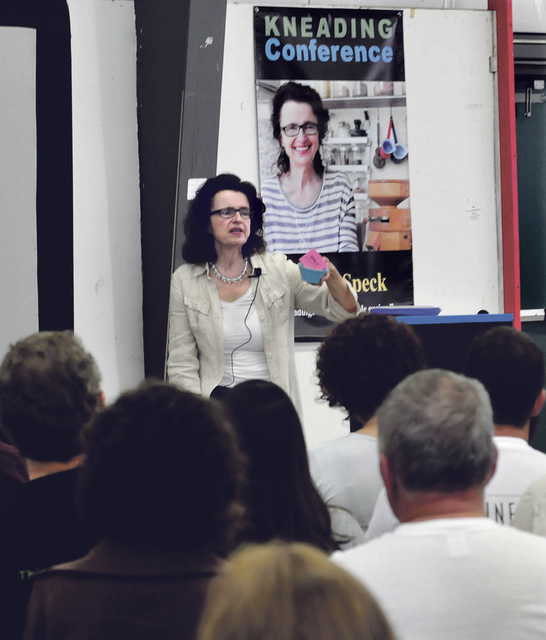SKOWHEGAN — Once you’ve had freshly milled flour, there’s no turning back.
That was the message from the keynote speaker Thursday at the eighth annual Kneading Conference. Some 200 bread and grain enthusiasts attended the event.
“If you’ve ever had fresh grain — I always compare it to a supermarket tomato and a farmers’ market tomato — it’s really that different,” said Maria Speck, an authority and author on the ancient grains. “It’s that different when you mill it and when you eat it. We don’t just eat to be healthy. If your food doesn’t taste good, you won’t eat it.”
Speck said the ancient whole grains that are coming back into favor in the United States are not processed — the original hull, fiber and germ are ground up together to make a very tasty — and healthy product, which is easier to digest and more tolerable for people with gluten sensitivity.
She said whole grains such as einkorn, emmer, spelt and kamut date back to the earliest agriculture practices and were used for centuries. Those grains, which still have a hard hull, were difficult to process, thus contributing to their fall from favor with the advent of industrial milling around 1870, according to Speck.
But industrial milling had its drawbacks in food taste and food nutrition, Speck said.
“It was the first time that an industrial change in food production didn’t improve our food,” she said. “It was making us sick.”
That milling practice led to modern flour — fluffy, industrial flour — that caused new problems with digestion in some people, mainly bloating and discomfort.
“If modern day wheat gives you discomfort, the try some of these ancient wheats, they are wonderful — I always tell people to try it,” she said. “When you buy whole wheat in a grocery store, what do you get? The grain is put into the mill, it is separated into bran, endosperm and germ and at some point it is reconstituted — combined — and sold to you as whole wheat and it’s not whole wheat — some parts of the grains are lost.”
Speck is the author of “Ancient Grains for Modern Meals,” a cookbook for which she was honored with the Julia Child Award, from the International Association of Culinary Professionals.
Speck said another variety of ancient grain — red fife — is processed in Skowhegan, at the Somerset Grist Mill. Speck said she had never tasted red fife wheat, but said it is a part of the “beautiful revival” of heirloom wheat and was immediately taken with its flavor.
“It’s absolutely mesmerizing, it’s so delicious and the flavor just blew me away,” she said. “I’d never had red fife before.”
Grist mill founder Amber Lambke, who also is chairman of the Maine Grain Alliance, the Kneading Conference host organization, said the grist mill is including some of the ancient grains in Maine for production, including red fife and einkorn wheat.
“We’re milling flour on a stone mills and preserving the identity of what kind of variety the grain is, where it was grown and when, so that customers can have freshly milled, intact flour,” Lambke said.
The Texas-based Whole Foods Market chain recently chose Maine Grains from Lambke’s Somerset mill to supply 10 tons of the heritage red fife flour for a new honey and wheat baguette the supermarket began producing. The baguette is baked at the Bread & Circus bakehouse in Medford, Mass., which supplies baked goods to more than 70 Whole Foods locations.
Kristen Fehlhaber, a journalist from Boston who was on hand Thursday to spread the word about the Kneading Conference on Facebook and Twitter, said Speck’s message will resonate with people who are interested in the farm-to-table revival.
“With her focus on ancient grains and everyone here really interested in whole grains and baking locally, we’re just trying to get the word out on the conference,” Fehlhaber said. “From Maria’s talk, I thought it was just great that she was making it really acceptable to use the whole grains.”
Deborah Richardso,n from Utica, N.Y., said she came to Skowhegan for the conference because of her interest in heritage foods and bought one of Speck’s cookbooks.
“We have a beautiful renaissance of grain growing in New York state — I thought her presentation was wonderful,” Fehlhaber said. “The takeaway from her piece is becoming familiar with the fact that there is an array of grains out there, ancient grains, but also the approach to it, that each one has a different flavor in our cooking — don’t be afraid in the kitchen.
“People sometimes are scared off from getting in the kitchen and just playing with food. She takes a real honest approach to cooking. Even the mistakes taste good.”
The conference continues Friday with a demonstration of wood-fired baking and making pizza with the heritage einkorn wheat.
Saturday is the day of the Artisan Bread Fair, which last year drew about 3,000 people to sample bread and pastries, as well as pizza baked in a wood-fired oven. Books and equipment for baking at home will be available, and professional bakers will be on hand to answer questions. The fair also will feature live music, exhibits of antique baking tools and kitchen linens, demonstrations and Maine-made food.
Doug Harlow — 612-2367
Twitter: @Doug_Harlow
Send questions/comments to the editors.




Success. Please wait for the page to reload. If the page does not reload within 5 seconds, please refresh the page.
Enter your email and password to access comments.
Hi, to comment on stories you must . This profile is in addition to your subscription and website login.
Already have a commenting profile? .
Invalid username/password.
Please check your email to confirm and complete your registration.
Only subscribers are eligible to post comments. Please subscribe or login first for digital access. Here’s why.
Use the form below to reset your password. When you've submitted your account email, we will send an email with a reset code.